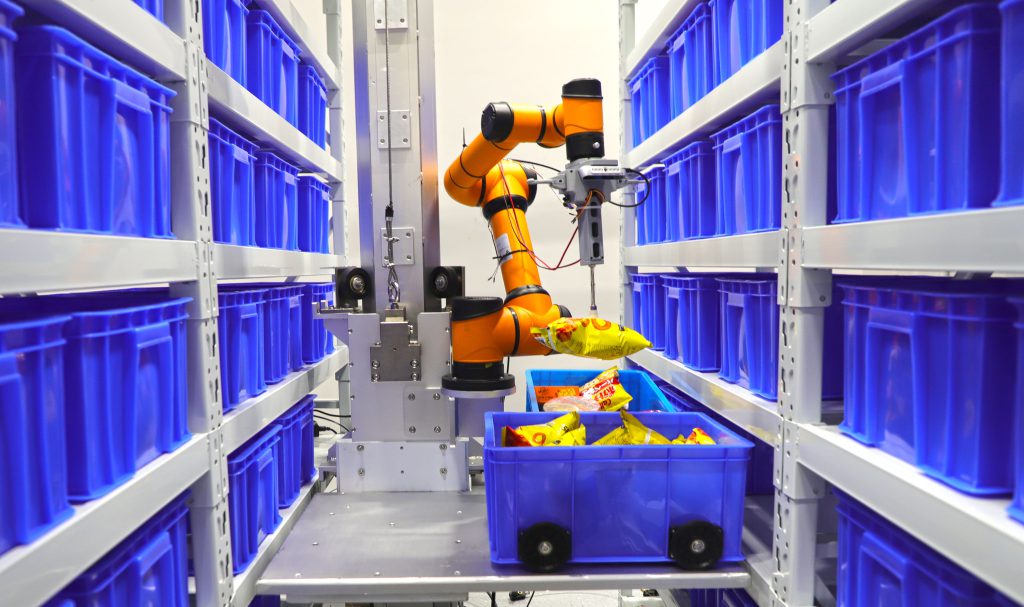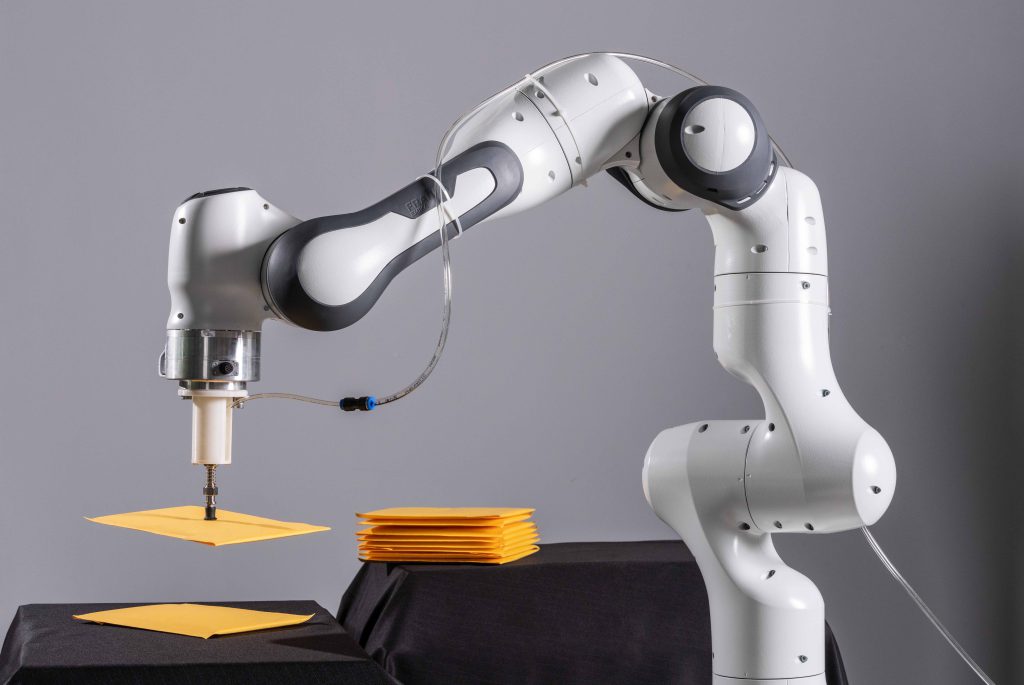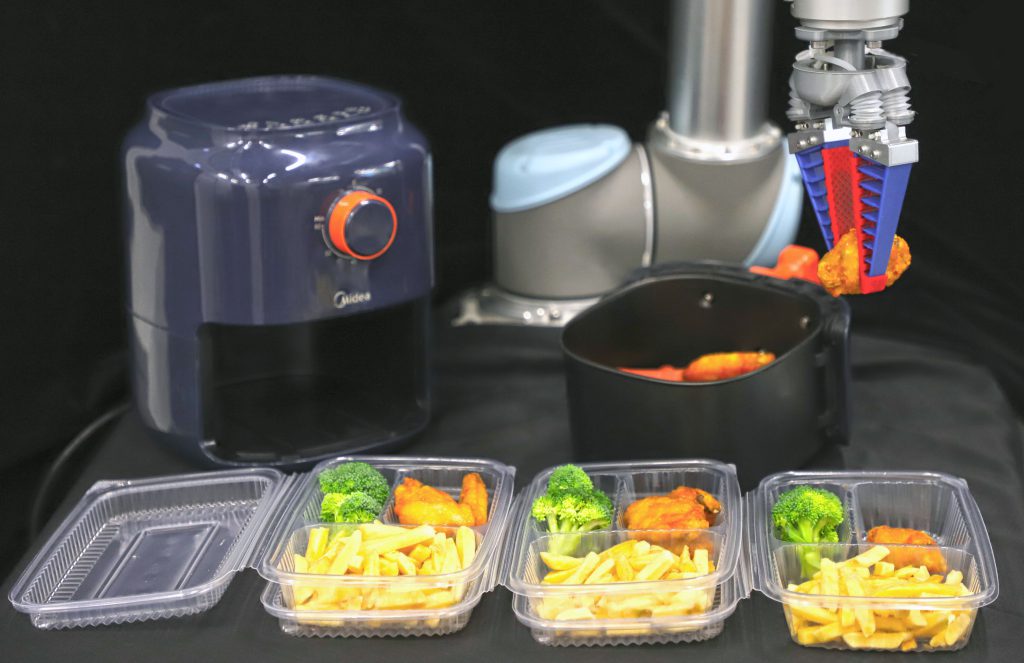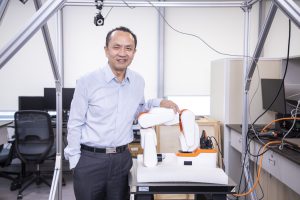Giving robots the gift of vision
Giving robots the gift of vision
In labour-intensive fields like logistics, construction and medicine, the demand for manpower continues to grow. In the Greater Bay Area, where competition for labour is particularly intense, more and more companies have started using automated robots in recent years to solve their manpower shortage. Some of those robots were invented by Professor Liu Yun-hui, who has spent years researching visual navigation, positioning, controlling and grasping theories, and building robots that automate all sorts of challenging tasks.

An ummanned, fully autonomous warehouse integrating intelligent logistics robotics specifically designed for e-commerce industry.
Training forklifts to operate themselves
Online shopping is booming worldwide, and it is driving demand for forklifts in the manufacturing, storage and logistics industries. In China, according to a report by the Industrial Truck Institution, more than 600,000 forklift vehicles were sold in 2020. Drivers are also in demand, but the tedious and repetitive nature of forklift operation deters many young people from joining the field. Rising salaries and management costs add to the troubles that the industries are facing.
“Six years ago, we developed a smart guidance system that can convert manual forklifts into automated ones to address the huge demand for unmanned operation in the mainland market. The system is equipped with a three-dimensional video lens that collect real-time data on the surrounding environment for autonomous guidance and positioning. The upgraded vehicle can navigate and carry goods around a complex and unreferenced depot with high precision and safe results without the need of human intervention,” said Professor Liu.

A smart forklift with a robotic gripper system provides one-stop intelligent automation solutions for the logistics industry. It can also be applied to the manufacturing, catering, and service industries.
The invention has been widely acclaimed, and several hundred of them have been sold. Its success is based on the reliability of the technology and the team’s solid research foundations. Over the past two decades, Professor Liu’s team has been dedicated to developing visual navigation, positioning and grasping theories, paving the way for various robotics applications. “Computer vision, the technology that enables machines to derive and analyse information from visuals, is the technical foundation that enables automated navigation, positioning, controlling, and grasping in industrial robots,” explained Professor Liu.
The smart gripper is the culmination of years of research by the team. It makes use of advanced lenses to analyse the three-dimensional space for the robotic arm to swiftly and flexibly perform grasping, distributing and stacking tasks, providing one-stop intelligent automation solutions for the logistics
industry. The gripper demonstrates great potential not only in the manufacturing industry but also in the catering and service sectors. Other inventions that use technologies developed by Professor Liu include a robotic endoscope and a robotic laparoscopic hysterectomy system. The former features a control pedal worn on one foot, meaning the surgeon’s hands are freed up to perform the operation; the latter can find the target tissues for the surgeon and tilt the uterus as required.
Rome wasn’t built in a day. Professor Liu went to Japan in the 1980s to study under Professor Suguru Arimoto, a world-renowned robotics expert, learning the essential robotics science that underpinned his future success. At that time, many talented researchers from mainland China who went overseas to pursue their studies shared a common purpose, and Professor Liu was no exception. “We wanted to bring knowledge back to China and lead the national development of science and technology. It was when Hong Kong was about to return to the motherland, and CUHK was focusing on robotics research, encouraged by Professor Sir Charles K. Kao, former Vice-Chancellor and President of CUHK. I came to this highly enthusiastic and vibrant city in 1995.”

The smart robotic gripping system with a soft mechanical arm can swiftly and flexibly perform the tasks of grasping, distributing and stacking goods. Demonstration of meal distribution and packaging as shown in the picture.
Let a Hundred Robotics Students Bloom
To promote the automation transformation of trades and professions in China, Professor Liu founded Smart Eye Tech Limited, a startup that offers technological solutions to meet business demands and help them tackle operational challenges.
In 2016, Professor Liu became the Director of the CUHK T Stone Robotics Institute. He later founded the Hong Kong Centre for Logistics Robotics under the InnoHK Research Clusters and set up a base at the Hong Kong-Shenzhen Innovation and Technology Research Institute (Futian). All these projects aim to recruit talented young personnel and encourage students to set up their businesses and promote the commercialisation of frontier robotics technology. After teaching for so many years, Professor Liu has quite a number of brilliant students to whom he feels more like an assistant than a teacher. “One of them developed a paint robot and set up a company in mainland China which helped the construction industry reduce manpower by 80% while tripling efficiency and significantly lowering the accident rate. I also have students whose robots can assist medical staff in conducting hearing tests or medical tasks like artificial insemination.” Professor Liu is expecting more successful cases like this in the future.
“As researchers, in addition to adhering to scientific value, we should also pay attention to social value. We should do our best to commercialise our research outputs to help industries and businesses.”
— Professor Liu Yun-hui
Director, CUHK T Stone Robotics Institute
Choh-Ming Li Professor of Mechanical and Automation Engineering
Research areas: Visual servoing, positioning, controlling and grasping theory
Major achievements:
- Founder of VisionNav Robotics and Smarteye Tech Limited
- Listed in the Highly Cited Authors (Engineering) by Thomson Reuters (2013)
- IEEE Fellow
- Editor-in-Chief of Springer Journal: Robotics and Biomimetics
- Holds more than 20 patents



